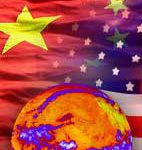Did the United States and China recently take a game-changing step on climate change and clean energy? Quite possibly so. With little fanfare, and to a chorus of disappointed commentators, the two countries at the end of July committed themselves to bilateral cooperation that could catalyse a global transition to low-carbon sustainable economic development.
The US-China “Memorandum of Understanding (MOU) to Enhance Cooperation on Climate Change, Energy and the Environment” issued at the end of the “Strategic and Economic Dialogue” (SED) has been generally viewed as less than earth-shaking. But these assessments may fail to appreciate the real strategic significance of the collaborative venture China and the United States are pledging to undertake.
Much of what was agreed to in this MOU had been part of policies and agreements worked out during the Bush administration, and for this reason it has been easy for many commentators to discount. But as they have parsed the statements, commitments and rhetoric about what was or was not agreed with a skeptical eye, many have missed the new strategic framework provided by this agreement.
This could all be boilerplate rhetoric with little long-term significance. Certainly, the MOU will have little strategic impact without serious, sustained follow through to realise the ambitious agenda of cooperation outlined in the agreement. But there is reason to believe that the two governments may actually follow through on their commitments and a long-term collaborative project with strategic implications will be undertaken.
First, the leadership of the two countries at the highest level now endorses climate-change science and takes seriously climate change as a critical strategic threat to both nations and the world. This is a major change that has taken place in China over the last two years and in the United States with the advent of the Obama administration. Second, the two governments are both committed to scaled-up domestic actions to implement policies aimed at transitioning their economies to clean-energy systems and low-carbon development. Third, the strong and public commitment by the leaders of the two countries to both meet the climate-change challenge and to engage in unprecedented US-China cooperation is a new and essential ingredient to energise the two governments at all levels and the two business communities to vastly scale up their collaborative as well as national efforts. Fourth, international and public pressure will continue to increase on the two biggest consumers of energy and producers of greenhouse-gas emissions to take effective and far-reaching steps to reduce their emissions and to cooperate with international efforts to reduce global emissions.
The prospects for success in this effort are quite uncertain, of course. Transforming the energy infrastructure of the two countries and of the rest of the world is a huge, expensive and multi-decade task that faces many obstacles and hurdles. The fight in the US Congress over establishing a “cap-and-trade” system is indicative of the strength and persistence of the interests that are threatened by change. China, too, has its vested interests who fear they will be losers in an energy transition or simply that the cost will be too high and economic growth will slow, creating social unrest and political instability.
There is one virtual certainty, however, which is that if the United States and China do not implement their new commitment to combat climate change, build clean energy systems and transition to low-carbon economies, the rest of the world is not likely to do so – and it may not matter whether they do or not. The US and China alone are currently on trajectories to produce more greenhouse gases than the world as a whole can be allowed to emit without crossing the climate change threshold limit of increasing the global temperature by 2 degrees Celsius.
It is unlikely the senior Chinese and American officials gathered for the SED were thinking about a multi-generational strategic commitment to transforming the world economic system. But there is a reasonable chance that a decade or two from now, their humble MOU will be pointed to as a historic turning point that marked a strategic shift as important in its global impact as the US-China opening nearly 40 years ago, which started with the secret July 1971 visit to Beijing by then national security adviser Henry Kissinger.
That visit and the subsequent US-China rapprochement played a key – if unanticipated – role in the transformation of the global strategic environment, ultimately contributing to the collapse of the Soviet Union, the end of the Cold War, the creation of one world economy, the re-emergence of China and the acceleration of globalisation. It may be that the US and China will reprise the strategic impact of their historic rapprochement by catalysing a global strategic transformation to sustainable, low-carbon development.
The MOU does not lay out such grandiose aims, of course. But the US-China agreement makes a number of critical points that set out both the strategic challenges and the aims of the US-China partnership on climate change and low-carbon transformation. First, this cooperation is based on a common understanding of the strategic threat faced by the two countries: “climate change, clean and efficient energy and environmental protection are among the greatest challenges facing the United States and China.” Second, the statement asserts the key role of US-China collaboration, noting that “cooperation between the United States and China is critical to enhancing energy security, combating climate change, and protecting the environment and natural resources…” Third, by implication, the agreement affirms that far-reaching and effective US-China cooperation is not only necessary, but also possible – and it sets out the framework for greatly deepening, broadening and accelerating this cooperation. Finally, and perhaps most importantly, the MOU asserts that “both countries intend to transition to a low-carbon economy…”
Indeed, the most important change—advocated by many critics calling for increased energy and climate cooperation between the United States and China—was the need to raise the issue to a strategic level. Many would agree that only with a strategic focus, fully backed by the top leaderships of the two countries, would it be possible to set out a long-term strategy that can be implemented and scaled up to achieve concrete goals that result in real change. Now that may have happened.
Banning Garrett is the director of the Asia Program at the Atlantic Council of the United States
Jonathan Adams is an associate in the Climate and Energy Program at the World Resources Institute
Homepage image from US Department of the Treasury. Treasury secretary Timothy Geithner and Chinese vice premier Wang Qishan at the Strategic and Economic Dialogue meeting in Washington in July.


